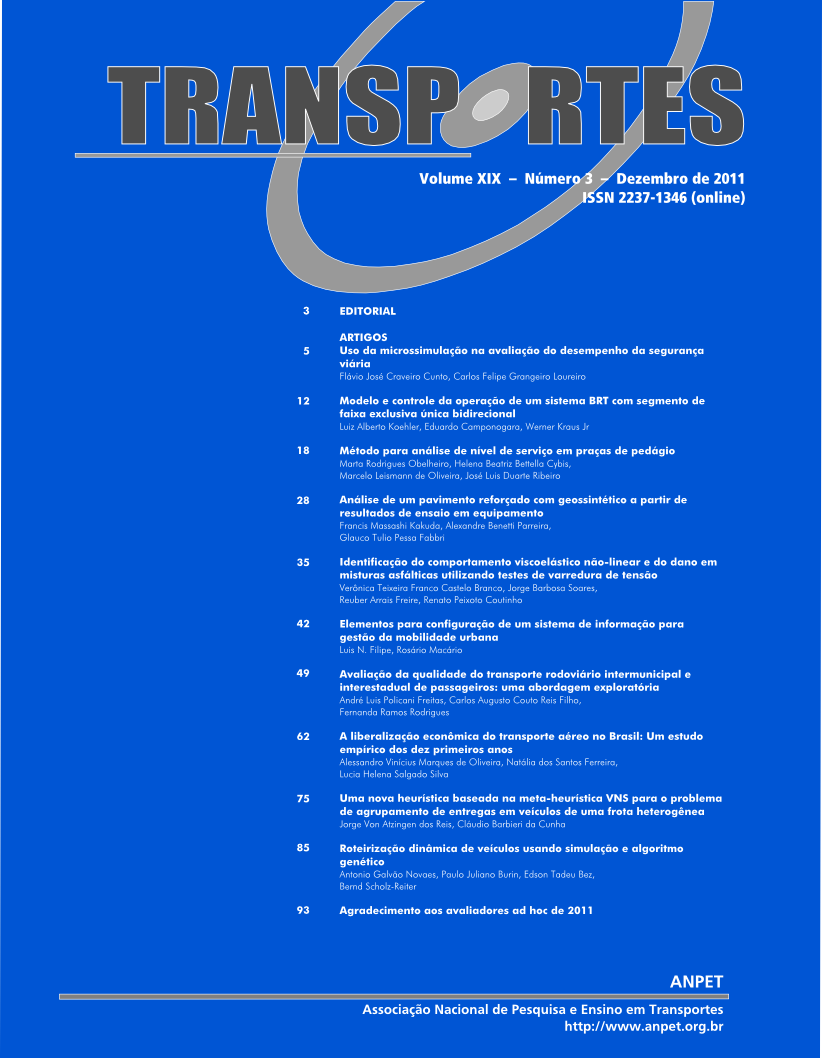Identificação do comportamento viscoelástico não-linear e do dano em misturas asfálticas utilizando testes de varredura de tensão
DOI:
https://doi.org/10.14295/transportes.v19i3.533Abstract
Resumo: Os materiais asfálticos apresentam comportamento que pode ser aproximado pela teoria da viscoelasticidade. Nesses materiais, é importante que seja feita a separação entre as respostas viscoelástica não-linear e de dano por fadiga. Este problema é complexo, pois nestas zonas (não-linear e dano) os materiais asfálticos apresentam comportamentos mecânicos semelhantes. Este trabalho apresenta um procedimento experimental e analítico para separação destas zonas em concretos asfálticos. Para isso foi utilizada uma máquina de teste universal (UTM-25) e ensaios de varredura de tensão em diferentes misturas asfálticas. Depois de coletados os valores de deslocamento, foi utilizada uma análise estatística para encontrar a tensão máxima que pode ser aplicada ao material sem que seja invocada a resposta referente ao dano por fadiga. Os resultados mostraram que o valor da tensão de transição está diretamente associadoàs propriedades do material, e que a rigidez pode ser um fator determinante.
Palavras-chave: misturas asfálticas, viscoelasticidade não-linear, dano por fadiga, varredura de tensão.
Abstract: Asphaltic materials are known to have a behavior that can be approximated by the viscoelasticity theory. In these materials it is essential to separate the nonlinear viscoelastic response from the fatigue damage response. This is a complex issue, because both nonlinearity and damage have a similar effect on the material mechanical behavior. This paper presents experimental and analytical procedures for separation of the nonlinear viscoelastic response from the fatigue damage in hot asphalt mixtures (HMA). A Universal Testing Machine 25 was used to perform stress sweep tests in three different HMAs. Once all the strain values were collected for each material, a statistical analysis was used to find the maximum stress that can be applied to the material without invoking the fatigue damage response. The results showed that the transition stress is directly associated with the material properties and stiffness can be a determining factor.
Keywords: asphalt mixtures, nonlinear viscoelasticity, fatigue damage, stress sweep.
Downloads
Download data is not yet available.
Downloads
Published
2011-07-02
How to Cite
Coutinho, R. P., Freire, R. A., Castelo Branco, V. T. F., & Soares, J. B. (2011). Identificação do comportamento viscoelástico não-linear e do dano em misturas asfálticas utilizando testes de varredura de tensão. Transportes, 19(3), 35–41. https://doi.org/10.14295/transportes.v19i3.533
Issue
Section
Articles
License
Authors who submit papers for publication by TRANSPORTES agree to the following terms:
- The authors retain the copyright and grant Transportes the right of first publication of the manuscript, without any financial charge, and waive any other remuneration for its publication by ANPET.
- Upon publication by Transportes, the manuscript is automatically licensed under the Creative Commons License CC BY 4.0 license. This license permits the work to be shared with proper attribution to the authors and its original publication in this journal.
- Authors are authorized to enter into additional separate contracts for the non-exclusive distribution of the version of the manuscript published in this journal (e.g., publishing in an institutional repository or as a book chapter), with recognition of the initial publication in this journal, provided that such a contract does not imply an endorsement of the content of the manuscript or the new medium by ANPET.
- Authors are permitted and encouraged to publish and distribute their work online (e.g., in institutional repositories or on their personal websites) after the editorial process is complete. As Transportes provides open access to all published issues, authors are encouraged to use links to the DOI of their article in these cases.
- Authors guarantee that they have obtained the necessary authorization from their employers for the transfer of rights under this agreement, if these employers hold any copyright over the manuscript. Additionally, authors assume all responsibility for any copyright infringements by these employers, releasing ANPET and Transportes from any responsibility in this regard.
- Authors assume full responsibility for the content of the manuscript, including the necessary and appropriate authorizations for the disclosure of collected data and obtained results, releasing ANPET and Transportes from any responsibility in this regard.









